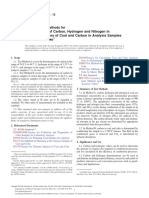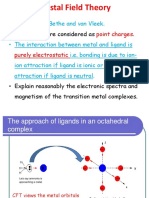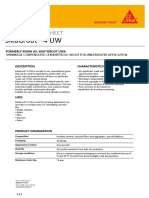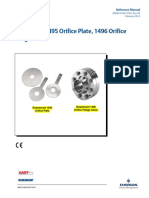Pesticide
Pesticide
Uploaded by
PalakshVismayCopyright:
Available Formats
Pesticide
Pesticide
Uploaded by
PalakshVismayOriginal Description:
Copyright
Available Formats
Share this document
Did you find this document useful?
Is this content inappropriate?
Copyright:
Available Formats
Pesticide
Pesticide
Uploaded by
PalakshVismayCopyright:
Available Formats
Pesticide degradation is the process by which a pesticide is transformed into a benign
substance that is environmentally compatible with the site to which it was applied. Globally, an
estimated 1 to 2.5 million tons of active pesticide ingredients are used each year, mainly in
agriculture. Forty percent are herbicides, followed by insecticides and fungicides. Since the discovery
of synthetic organochlorine compounds in the 1940s, multiple chemical pesticides with different
uses and modes of action have been employed. Pesticides are applied over large areas in agriculture
and urban settings. Pesticide use therefore represents an important source of diffuse chemical
environmental inputs
Contents
1 Persistence
2 Biotic transformation
3 Abiotic Transformation
4 Prediction
5 Transformation products
Persistence
In principle, pesticides are registered for use only after they are demonstrated not to persist in the
environment considerably beyond their intended period of use.
Pesticide residues have been found in other realms. Transport from groundwater may lead to low-
level presence in surface waters. Pesticides have been detected in high-altitude regions,
demonstrating sufficient persistence to survive transport across hundreds of kilometers in the
atmosphere.
Degradation involves both biotic and abiotic transformation processes. Biotic transformation is
mediated by microorganisms, while abiotic transformation involves processes such as chemical and
photochemical reactions. The specific degradation processes for a given pesticide are determined by
its structure and by the environmental conditions it experiences.
Biotic transformation
degradation is generally recognized as biggest contributor to degradation. Whereas plants, animals
and fungi typically transform pesticides for detoxification through metabolism by broad-spectrum
enzymes, bacteria more commonly metabolize them. This dichotomy is likely due to a wider range of
sensitive targets in Eukaryota such enzymes because of their strong selection for new enzymes and
metabolic pathways that supply essential nutrients.
Biodegradation transformation intermediates may accumulate when the enzymes that produce the
intermediate operate more slowly than those that consume it
Pesticides persist over decades in groundwater, although bacteria are in principle abundant and
potentially able to degrade them for unknown reasons. This may be related to the observation that
microbial degradation appears to stall at low pesticide concentrations in low-nutrient environments
such as groundwater. As yet, very little is known about pesticide biodegradation under such
conditions
Abiotic Transformation
In surface waters, phototransformation can substantially contribute to degradation. In “direct”
phototransformation, photons are absorbed by the contaminant, while in “indirect”
phototransformation, reactive species are formed through photon absorption by other substances.
Microorganisms often mediate the latter, blurring the boundary between abiotic and biotic
transformations. Chemical reactions may also prevail in compartments such as groundwater or lake
hypolimnions, which have hydraulic retention times on the order of years and where biomass
densities are lower due to almost complete absence of assimilable organic carbon.
Prediction
Available strategies to identify in situ pesticide transformation include measuring remnant or
transformation product concentrations and estimation of a given environment's theoretical
transformation potential. Measurements are only usable on the micro- scale.
Transformation products
Even though their undesirable effects are typically lowered, transformation products may remain
problematic. Some transformations leave active moiety intact, such as oxidation of thioethers to
sulfones and sulfoxides. Parent/transformation product mixtures may have additive effects. Second,
some products are more potent than their parents. Phenolic degradates of such diverse chemical
classes as pyrethroids and aryloxyphenoxypropionic herbicides may act on estrogen receptor. Such
products should receive particular attention because they are often smaller and more polar than
their parents. This increases their potential to reach drinking water resources such as groundwater
and surface waters, where polar products are found at fairly constant concentrations. Products in
drinking water resources may cause problems such as formation of carcinogenic N-nitroso-
dimethylamine from dimethylsulfamide, a microbial product of the fungicides tolylfluanide and
dichlofluanide, during water treatment with ozone.
You might also like
- Scioly Green Generation NotesDocument2 pagesScioly Green Generation NotesApril Lovely100% (1)
- Biofloc - A Technical Alternative For Culturing Malaysian PrawnDocument18 pagesBiofloc - A Technical Alternative For Culturing Malaysian PrawnclaudiousdecastroNo ratings yet
- Vapo Hybrid ECO: Textile Steaming SystemDocument6 pagesVapo Hybrid ECO: Textile Steaming SystemSajjad AhmedNo ratings yet
- NPB 168 Practice Exam 2Document5 pagesNPB 168 Practice Exam 2Kim Wong100% (1)
- Bioremediation: Resna N K Assistant Professor Gems CollegeDocument40 pagesBioremediation: Resna N K Assistant Professor Gems CollegeResna N K ResiNo ratings yet
- Bio RemediationDocument18 pagesBio RemediationaokankNo ratings yet
- A General Essay On Bioremediation of Contaminated SoilDocument5 pagesA General Essay On Bioremediation of Contaminated SoildianpalulinaNo ratings yet
- Treated Effluent DisposalDocument5 pagesTreated Effluent DisposalvipinNo ratings yet
- Assignment ChemDocument4 pagesAssignment ChemSharifah Aziah JasmineNo ratings yet
- Xenobiotic CompoundsDocument6 pagesXenobiotic CompoundsAnonymous 87RCHLRNo ratings yet
- Xenobiotics in Biological SystemsDocument11 pagesXenobiotics in Biological SystemsG S MalhotraNo ratings yet
- BIOREMEDIATIONDocument31 pagesBIOREMEDIATIONTU_MTECH_ENV11No ratings yet
- Bio RemediationDocument24 pagesBio RemediationMinhaj HaiderNo ratings yet
- JOASHEDocument3 pagesJOASHErobertmuhirwa7No ratings yet
- Decomposition of Organic Matter in WaterDocument6 pagesDecomposition of Organic Matter in WaterDivya Reddy100% (1)
- Bioremediation: How Does Bioremediation WorksDocument4 pagesBioremediation: How Does Bioremediation WorksswtoNo ratings yet
- Microbiology of WastewaterDocument5 pagesMicrobiology of WastewaterAnupriyaNo ratings yet
- Bioremediation: Eco Technology of Cultured Water Using Efficient Microbes (ECO Microbes)Document6 pagesBioremediation: Eco Technology of Cultured Water Using Efficient Microbes (ECO Microbes)NehaNo ratings yet
- Environmental Microbiology Mid TermDocument24 pagesEnvironmental Microbiology Mid Termasraafzal2000No ratings yet
- Bioremediation: Rohit Chandak 1MS08CH038Document20 pagesBioremediation: Rohit Chandak 1MS08CH038Rohit ChandakNo ratings yet
- Libro de MacrofitaDocument21 pagesLibro de MacrofitaELIANA ORTIZNo ratings yet
- BioremediationDocument53 pagesBioremediationLaxusPlayzNo ratings yet
- Tertiary Treatment of Wastewater With Chlorella Vulgaris-A Literature ReviewDocument7 pagesTertiary Treatment of Wastewater With Chlorella Vulgaris-A Literature ReviewIOSRjournalNo ratings yet
- Pesticide: Field of Nuclear Chemical Engineering, Polytechnic Institute of Nuclear Technology, Yogyakarta, IndonesiaDocument9 pagesPesticide: Field of Nuclear Chemical Engineering, Polytechnic Institute of Nuclear Technology, Yogyakarta, IndonesiaaldiyaldiesNo ratings yet
- Bio IndicatorsDocument30 pagesBio IndicatorsKaif AhmedNo ratings yet
- Basic CivilDocument4 pagesBasic CivilprasaddivekarNo ratings yet
- What Is Eutrophication? What Is The Causes of Eutrophication? Discuss The Consequences and Controls of Eutrophication in Aquatic EcosystemsDocument17 pagesWhat Is Eutrophication? What Is The Causes of Eutrophication? Discuss The Consequences and Controls of Eutrophication in Aquatic EcosystemsTagay AlemuNo ratings yet
- BIOREMEDIATION GoodDocument8 pagesBIOREMEDIATION GoodAmiruddin AliNo ratings yet
- Topic: Abiotic Factors: ExamplesDocument2 pagesTopic: Abiotic Factors: ExamplesVINDHYA SHANKERNo ratings yet
- Wk2 Bioremediation and Bio DegradationDocument52 pagesWk2 Bioremediation and Bio DegradationraitavNo ratings yet
- Agriculture Microbiology CombinedDocument17 pagesAgriculture Microbiology Combinedizirare hamadiNo ratings yet
- Development of Alternate Cleaner Technologies Using BiotechnologyDocument6 pagesDevelopment of Alternate Cleaner Technologies Using BiotechnologyNeeraj AnsalNo ratings yet
- Bioremediation of Aquaculture WastesDocument5 pagesBioremediation of Aquaculture WastesWilliam MonteroNo ratings yet
- Biological Process in Soil: Mayrina FirdayatiDocument19 pagesBiological Process in Soil: Mayrina FirdayatiEster MelindaNo ratings yet
- Amadi Chineme Agashi SeminarDocument55 pagesAmadi Chineme Agashi SeminarNwachukwu MunachiNo ratings yet
- Basic Ecological Concepts and PrinciplesDocument8 pagesBasic Ecological Concepts and PrinciplesangkatekagNo ratings yet
- Agricultural Wastewater TreatmentDocument22 pagesAgricultural Wastewater TreatmentAna Marie AllamNo ratings yet
- Unit IV - Bioremidiation ConceptDocument96 pagesUnit IV - Bioremidiation ConceptRajeev PotadarNo ratings yet
- Plantmate Aud & NZ 2Document98 pagesPlantmate Aud & NZ 2rohitpnfNo ratings yet
- Environment 4Document5 pagesEnvironment 4Atul SinghNo ratings yet
- 1985 - Alexander - Biodegradation of Organic ChemicalsDocument6 pages1985 - Alexander - Biodegradation of Organic ChemicalsMarcus Adonai Castro da SilvaNo ratings yet
- Lab 8 - Nutrient Pollution (1)Document8 pagesLab 8 - Nutrient Pollution (1)asemkhattab2005No ratings yet
- Plant-Microbe Interaction As Drivers of Ecosystem Functions Relevant For The Biodegradation of Organic ContaminantsDocument8 pagesPlant-Microbe Interaction As Drivers of Ecosystem Functions Relevant For The Biodegradation of Organic ContaminantsSara AlmeidaNo ratings yet
- 16. Biodegradation and BioremediationDocument29 pages16. Biodegradation and Bioremediationchudieuanh77No ratings yet
- Bio RemediationDocument18 pagesBio Remediationsharma28No ratings yet
- Pseudomonas in Biodegradation PDFDocument10 pagesPseudomonas in Biodegradation PDFPenelope MeloNo ratings yet
- Water AssgDocument6 pagesWater AssgYulNo ratings yet
- Water Quality and Water Quality Management in AquacultureDocument20 pagesWater Quality and Water Quality Management in AquacultureAhmed Rashid100% (1)
- Environmental ScienceDocument28 pagesEnvironmental ScienceAbdul RashadNo ratings yet
- Environment Pollution and Global Climatic ChangeDocument81 pagesEnvironment Pollution and Global Climatic ChangeHalimaNo ratings yet
- Role of Microorganisms in Degradation, Recalcitrant Chemicals, Persistent Organic PollutantsDocument6 pagesRole of Microorganisms in Degradation, Recalcitrant Chemicals, Persistent Organic PollutantsAMRITHA NAIR J MNo ratings yet
- _plant and soil relationshipsDocument4 pages_plant and soil relationshipssaniatayyeba78No ratings yet
- Biosurfactants As Useful Tools in BioremediationDocument19 pagesBiosurfactants As Useful Tools in BioremediationDenny H. PiliangNo ratings yet
- BIOREMDIATIONDocument9 pagesBIOREMDIATIONMae Nielyn PadilloNo ratings yet
- Biotechnological Methods For ManagementDocument29 pagesBiotechnological Methods For ManagementTausif AhmadNo ratings yet
- Ecology, Microbial: AbbreviationDocument15 pagesEcology, Microbial: AbbreviationAndres ArenasNo ratings yet
- Biofloc Technology (BFT) and Its ApplicationDocument5 pagesBiofloc Technology (BFT) and Its ApplicationrobiyullahNo ratings yet
- Biofloc Fish Farming: Sustainable Practices for Marine and Freshwater SpeciesFrom EverandBiofloc Fish Farming: Sustainable Practices for Marine and Freshwater SpeciesNo ratings yet
- Aquaponics Bacteria: Importance of Bacterias in Aquaponics SystemFrom EverandAquaponics Bacteria: Importance of Bacterias in Aquaponics SystemRating: 3 out of 5 stars3/5 (1)
- Water Pollution ControlFrom EverandWater Pollution ControlSuresh T. NesaratnamNo ratings yet
- English CoursesDocument4 pagesEnglish CoursesPalakshVismayNo ratings yet
- 1.village Water Supply Project. 2.restoration of Old Tank Project. 3.new Highway Project. 4.town Planning Project. 5.new Tank ProjectDocument7 pages1.village Water Supply Project. 2.restoration of Old Tank Project. 3.new Highway Project. 4.town Planning Project. 5.new Tank ProjectPalakshVismayNo ratings yet
- Table 2 Table 2Document15 pagesTable 2 Table 2PalakshVismayNo ratings yet
- List of Table and List of ChartDocument2 pagesList of Table and List of ChartPalakshVismayNo ratings yet
- Evaluation of Crude DrugsDocument13 pagesEvaluation of Crude DrugsPalakshVismayNo ratings yet
- Moniza AlviDocument14 pagesMoniza AlviPalakshVismayNo ratings yet
- Consumers Equilibrium Price Income and Substituion Effects. Contetns. 1. Intruducation 2. Consumers Equilibrium 3. Income Effects 4. Pricec Effcets 5. Substitution Effects 6. ConclusionDocument10 pagesConsumers Equilibrium Price Income and Substituion Effects. Contetns. 1. Intruducation 2. Consumers Equilibrium 3. Income Effects 4. Pricec Effcets 5. Substitution Effects 6. ConclusionPalakshVismayNo ratings yet
- Dedicated To Our Beloved Soldiers, Teachers and ParentsDocument1 pageDedicated To Our Beloved Soldiers, Teachers and ParentsPalakshVismayNo ratings yet
- Definition 3. Use of Regression 4. Difference Between Correlation and Regression 5. Method of Studying Regression 6. Conclusion 7. ReferenceDocument11 pagesDefinition 3. Use of Regression 4. Difference Between Correlation and Regression 5. Method of Studying Regression 6. Conclusion 7. ReferencePalakshVismayNo ratings yet
- Dedicated To Our Beloved Parents, Teachers &friendsDocument5 pagesDedicated To Our Beloved Parents, Teachers &friendsPalakshVismayNo ratings yet
- Puma Se 01 2014 PDFDocument4 pagesPuma Se 01 2014 PDFPalakshVismayNo ratings yet
- Four Stars Tourism: AC NO - 0333102000004855 MOB-9242988439Document2 pagesFour Stars Tourism: AC NO - 0333102000004855 MOB-9242988439PalakshVismayNo ratings yet
- RDInstallmentReport25 04 2017 PDFDocument2 pagesRDInstallmentReport25 04 2017 PDFPalakshVismayNo ratings yet
- Economics 3Document21 pagesEconomics 3PalakshVismayNo ratings yet
- Om Sri Sai Ram आआ आआ आआआआDocument4 pagesOm Sri Sai Ram आआ आआ आआआआPalakshVismayNo ratings yet
- Search Criteria Agent Id: MI5771020200022: Recurring Deposit Installment ReportDocument2 pagesSearch Criteria Agent Id: MI5771020200022: Recurring Deposit Installment ReportPalakshVismayNo ratings yet
- BorderDocument2 pagesBorderPalakshVismayNo ratings yet
- RDInstallmentReport25 04 2017 PDFDocument2 pagesRDInstallmentReport25 04 2017 PDFPalakshVismayNo ratings yet
- Galigudde Halla, Galigudde Village, Chikmagalur: Conductivity Date of Collection of Sample ResultDocument20 pagesGaligudde Halla, Galigudde Village, Chikmagalur: Conductivity Date of Collection of Sample ResultPalakshVismayNo ratings yet
- RDInstallmentReport25 04 2017 PDFDocument2 pagesRDInstallmentReport25 04 2017 PDFPalakshVismayNo ratings yet
- Search Criteria Agent Id: MI5771020200022: Recurring Deposit Installment ReportDocument1 pageSearch Criteria Agent Id: MI5771020200022: Recurring Deposit Installment ReportPalakshVismayNo ratings yet
- Specimen Cold Chain RequirementsDocument6 pagesSpecimen Cold Chain RequirementsNikkae Angob0% (1)
- Hydrates of Natural Gas: January 1974Document9 pagesHydrates of Natural Gas: January 1974Ricardo HernandezNo ratings yet
- Oerlikon Competence 3 Grade 92 2008Document32 pagesOerlikon Competence 3 Grade 92 2008Claudia MmsNo ratings yet
- 1.2b DNA Structure & Replication TBL1.2 STQ (QP)Document3 pages1.2b DNA Structure & Replication TBL1.2 STQ (QP)James LimNo ratings yet
- ASTM D5373-13 - CHN in Coal and Coke-3Document11 pagesASTM D5373-13 - CHN in Coal and Coke-3Luis M Molina100% (1)
- Arar-Medical Gas PipeDocument3 pagesArar-Medical Gas Pipeneng oudomNo ratings yet
- Crystalline Membrane Epoxy Primer ES-P001 Rev3Document2 pagesCrystalline Membrane Epoxy Primer ES-P001 Rev3Luqman malikNo ratings yet
- Carbo SanDocument6 pagesCarbo Sanz3bas3699No ratings yet
- Waters Method DevelopmentDocument50 pagesWaters Method DevelopmentSouradipta GangulyNo ratings yet
- Forced Degradation Studies To Assess The Stability of Drugs and ProductsDocument18 pagesForced Degradation Studies To Assess The Stability of Drugs and ProductsSoraya OchsNo ratings yet
- 2013 - The History Development and Future Prospects For Laser Ceramics - A ReviewDocument9 pages2013 - The History Development and Future Prospects For Laser Ceramics - A ReviewArun KumarNo ratings yet
- Steel 51crv4Document5 pagesSteel 51crv4bennyfergusonNo ratings yet
- Genei: Student PCR Teaching Kit ManualDocument13 pagesGenei: Student PCR Teaching Kit ManualSoma GhoshNo ratings yet
- KW Infrared Absorbing Oxides 2019-V9Document40 pagesKW Infrared Absorbing Oxides 2019-V9qkzxbik734No ratings yet
- June 2019 P1 - Chemistry A LevelDocument7 pagesJune 2019 P1 - Chemistry A LevelDarrel NgadjuiNo ratings yet
- Engine Cooling SystemsDocument31 pagesEngine Cooling SystemsPujara Manish100% (2)
- Avoid Costly Materials mistakes-CEDocument23 pagesAvoid Costly Materials mistakes-CEManish542No ratings yet
- Capítulo 29 de WeltyDocument31 pagesCapítulo 29 de WeltyJosé Daniel LimaNo ratings yet
- Virtual Lab-Water QualityDocument5 pagesVirtual Lab-Water Qualityapi-264283755No ratings yet
- FS247EDocument6 pagesFS247EBlumNo ratings yet
- National Standard Examination in Chemistry (NSEC) Solved Paper 2016 Part-1Document2 pagesNational Standard Examination in Chemistry (NSEC) Solved Paper 2016 Part-1Destroyer74No ratings yet
- Practice Final Examination Answer Key: Rade CienceDocument19 pagesPractice Final Examination Answer Key: Rade CienceMadel CatayloNo ratings yet
- Inspiring Learning: History, Defination and Scope of PharmacognosyDocument61 pagesInspiring Learning: History, Defination and Scope of Pharmacognosyradicalajaypal67% (3)
- Resume Elektro AdsorptionDocument2 pagesResume Elektro AdsorptionRiska RistiyantiNo ratings yet
- JDLee Coordination CFT Example Problems PDFDocument21 pagesJDLee Coordination CFT Example Problems PDFArpit PradhanNo ratings yet
- Sikagrout - 4 UwDocument3 pagesSikagrout - 4 UwTanveer Hussain ButtNo ratings yet
- Mass PercentDocument29 pagesMass PercentAbby SevillaNo ratings yet
- Placa de OrificioDocument74 pagesPlaca de OrificioAriely Menacho MontenegroNo ratings yet














































































































